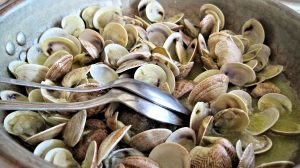 Cobalamin—vitamin B12—is important for all cells in the body. It helps make the genetic material in each and every cell, so imperative for all functions, too. Megaloblastic anemia, which creates weakness and exhaustion, is prevented by adequate Vitamin B12. The body absorbs this vitamin through natural sources of B12, such as animal products, like fish, eggs, poultry, milk products and while not present in plant based food, it is supplemented in fortified breakfast cereal and nutritional yeast products.
Cobalamin—vitamin B12—is important for all cells in the body. It helps make the genetic material in each and every cell, so imperative for all functions, too. Megaloblastic anemia, which creates weakness and exhaustion, is prevented by adequate Vitamin B12. The body absorbs this vitamin through natural sources of B12, such as animal products, like fish, eggs, poultry, milk products and while not present in plant based food, it is supplemented in fortified breakfast cereal and nutritional yeast products.
Signs of low vitamin B12 may occur if you don’t eat enough or have problems preventing absorption.
Besides feeling exhausted or even lightheaded, you may experience heart palpitations, shortness of breath, a smooth tongue, pale skin, digestive issues like diarrhea, constipation, appetite loss or gas. Low vitamin B12 can cause muscle weakness, numbness or tingling, vision loss and even mental issues, such as depression, memory loss and changes in behavior. Stomach problems, pernicious anemia, digestive issues lie celiac disease and Crohn’s, immune system disorder, such as Graves or lupus and certain medications, including heartburn medicines, some diabetes meds, PPIs and H2 blockers affect the absorption.
It’s easy to get adequate vitamin B12 unless you’re a vegetarian.
Animal products are the best sources of vitamin B12. The very best sources include clams and animal liver or kidneys. Three ounces of cooked clams, about ten small clams, contains 3500 % of the daily value. That same three ounces of beef liver contains almost 3, 000 % of the daily value with lamb and beef liver containing more. Seafood, like trout and salmon, have over 200 % of the daily value and three ounces of grilled steak provides half your daily amount. Poultry contains the least amount of all the animal products.
Foods vegetarians can eat to get vitamin B12.
The plant world doesn’t offer lots of options for this important nutrient. There are two sources, but only one natural source. Nutritional yeast is not a natural source of vitamin B12, plus a good source of other vitamins and minerals, as well as protein. It’s a food product, not the type of yeast used in bread to make it rise. It’s yeast that’s specifically grown as food and synthetically made. Two tablespoons of nutritional yeast provide over 700% of the DV for B12. The other source of B12 is fortified cereal, which is far lower per average serving. Read the label to find how much B-12 each contains, since it varies.
- Your body absorbs B12 in the stomach via an intrinsic factor. Any excess B12 is stored in the liver for future use. It’s also one reason animal liver is so high in B12.
- Vitamin B12 is absorbed in the stomach with the help of a protein called intrinsic factor. This substance binds to the vitamin B12 molecule and facilitates its absorption into your blood and cells.
- Your body stores excess vitamin B12 in the liver, so if you consume more than the RDI, your body will save it for future use.
- While meat, fish and poultry are loaded with B12, the absorption rate is only approximately between 42% and 60%. Milk products, like yogurt have an absorption rate of around 50% to 80%. Eggs absorption rate is approximately 9%.
For more information, contact us today at LIV Fitness
